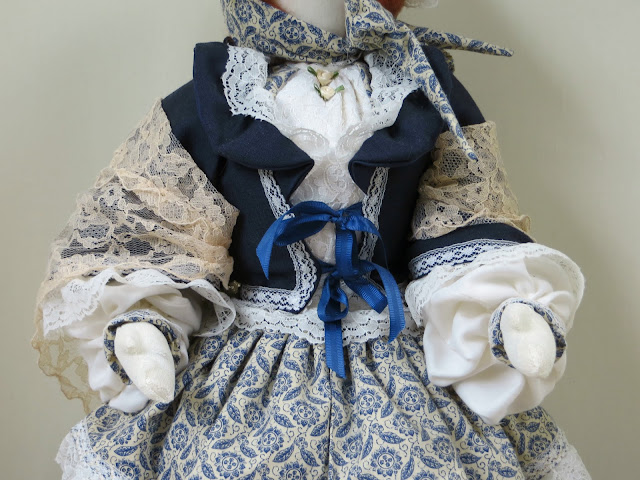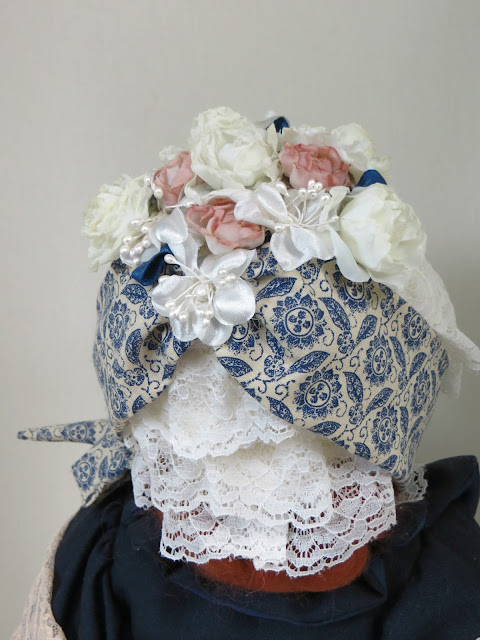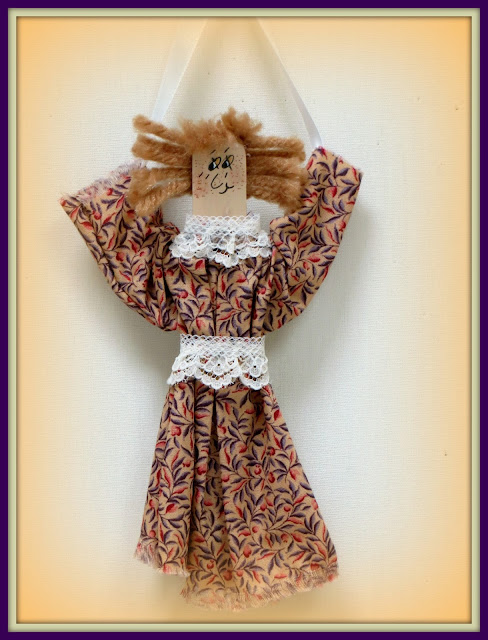With Halloween comes the most recognized of the villains - the witches.
That got me to thinking a little bit about witches. And, of course, when I get to thinking about something I inevitably wonder about their history and what started the fear of "witches?" This fear might better be defined as a "manic craze" that lasted for hundreds of years. YIKES!
Now, I might be a little more curious about "witches" than I should be. You see, I was actually born in the state that is notorious for witches, witchcraft, and witch trials. Plus, in my genealogy search I found there may be a witch or two in my family in the past! YIKES!
Maybe I'm actually a modern day witch? Nah!!!! Witches don't like Victorian dolls - or do they?
So, where did it all begin?
The most notorious of the witch lore was the Salem witch trials and the
Smithsonian.com website has a wonderful history of the Salem witch trials entitled:
A Brief History of the Salem Witch Trials - One town's strange journey from paranoia to pardon - Smithsonian.com, October 24, 2007 - - By Jess Blumberg. It is well worth reading.
But, before the witch trials where did the fear of witches begin?
Maybe the place to start is with the definition of a witch.
So, what exactly is a witch?
Well, according to
The Free Dictionary a witch is defined as:
1. A woman claiming or popularly believed to possess magical powers and practice sorcery.
2. A believer or follower of Wicca; a Wiccan.
3. A hag.
4. A woman considered to be spiteful or overbearing.
5. Informal A woman or girl considered bewitching.
6. One particularly skilled or competent at one's craft: "A witch of a writer, [she] is capable of developing an intensity that verges on ferocity" (Peter S. Prescott)
Well, that's a pretty broad definition. Just being an ugly evil looking old woman (i.e. hag) can get you defined as a witch. With that definition a lot of us are in trouble! YIKES!
Maybe a sorcerer, magician, or devil worshiper is more like it. I tend to think that most everyone would classify a witch as someone who can cast a spell over you. Wouldn't you agree? If so, that person is practicing witchcraft.
According to
Wikipedia.com "witchcraft" is defined as follows:
Witchcraft (also called witchery or spellcraft) is the use of magical faculties, most commonly for religious, divinatory or medicinal purposes. This may take many forms depending on cultural context.
The belief in and the practice of magic has been present since the earliest human cultures and continues to have an important religious and medicinal role in many cultures today.
"Magic is central not only in 'primitive' societies but in 'high cultural' societies as well..."
The concept of witchcraft as harmful is often treated as a cultural ideology providing a scapegoat for human misfortune. This was particularly the case in the early modern period of Europe where witchcraft came to be seen as part of a vast diabolical conspiracy of individuals in league with the Devil undermining Christianity, eventually leading to large-scale witch-hunts, especially in Protestant Europe. Witch hunts continue to this day with tragic consequences.
Since the mid-20th century Witchcraft has become the designation of a branch of modern paganism. It is most notably practiced in the Wiccan and witchcraft traditions, some of whom claim to practice a revival of pre-Abrahamic spirituality.
The word witchcraft means "craft of the wise" and witchcraft is thought to be the oldest of religions.
As with many things in folklore some believe the roots of witchcraft come from the Celts living between 700 BC and 100 AD. The Celts and their religious leaders, the Druids, were spiritual people, who worshiped both a god, a goddess, and believed in reincarnation. Some historians say that witches date back to the days when the goddess was worshiped. During that time there was great respect for the powers of nature and for women as the creators of life. However, there are some who believe that witchcraft was alive well before the "Druids" and around 1800 B.C.
Witches, in fact, were respected members of the community up to about 1,000 A.D. They were valued for their ability to ease pain, heal people, and heal sick animals.
The religious beliefs and practices of the Celts became known as Paganism. Some say that their any beliefs and rituals spawned many of the practices associated with witches, such as: concocting potions, mixing ointments, casting spells, dabbling in the supernatural, forecasting the future, and performing feats of magic. These practices and many of the nature-based beliefs held by the Celts and others became known as witchcraft.
So, what led people to a fear of witches or, in other words, witch hunts, which is a search for witches? The inevitable result being burned at the stake or lynched? Yikes!
Around the 14Th century with the rise of Christianity and demise of paganism witchcraft became branded as "demon-worship." Witches became feared because with their knowledge of healing, herbs, hypnosis, etc. they could do things that the majority of the population and the religious leaders could not do. This was too threatening so the Christian Church taught that those claiming to heal outside the context of the Church (healing through faith and prayer) were thought to have obtained their skills from the Devil.
When North America started being settled witchcraft was practiced by some of the early colonial settlers in order to help the early settlers save their settlements from attacks by the Indians.
In some instances, the witches were put on trial before being burned alive or hung. I'll bet the witches wouldn't agree that they had fair trials - now would they? More like mass hysteria leading to execution would be a better description. Mass hysteria led by instigators who had an ulterior motive for persecuting the wrong-doers.
Witch hunts in Europe started around 1480 and went until 1700 during which there were anywhere from 40,000 to 100,000 executions. By most accounts people were accused of witchcraft in order to explain some human misfortune that couldn't be explained else-wise. Something supernatural. Something that bewitched someone causing them to behave in an anti-social manner.
However, not all witches were the same. Some were bad witches and some were actually good witches. Some were sorcerers, some were midwifes, some were just plain healers.
In the Christian religion sorcery came to be associated with heresy and the denouncing of one's beliefs, which of course was very threatening to religious leaders of the time.
In Europe during the medieval times the fear of witchcraft rose to the level of mass hysteria resulting in numerous witch hunts. It was believed that the witches had entered into a pact with the devil and were being directed by the devil himself to commit unthinkable acts. Hundreds of thousands of people (mainly women) were executed, tortured and imprisoned.
In Europe witches have typically been women. As with a lot of beliefs, witchcraft began with the pagan belief in witchcraft that was associated with the goddess Diana, who was the ancient Roman goddess of the moon, the hunt, and chastity.
Most witches were thought to have the ability to cast a "spell" upon someone - good or bad. Some were also thought to have the ability to conjure up the dead and/or ability to talk to the spirit of a deceased person. Some early Christian authorities believed that witches made deals with the devil to gain power over infertility, child welfare, or even revenge against a lover. Witches had the power to disrupt marriage. All of which were seen as acts against the church.
According to folklore witches inevitably had the mark of the devil - which was a brand placed on their skin to signify their deal with the devil. YIKES!
However, not all witches were "evil." There were "good" witches or "white" witches who were able to heal the sick, who meditated, and brewed potions at the request of the person inflicted. These potions could heal the person inflicted versus causing them to act against their will. Good healing power, in other words, power that was beneficial was tolerated and acceptable behavior.
Within witchcraft itself there were different levels of "magic." "Black magic" is used to harm another human being. " Green magic" is used to align oneself with nature. "White magic" is used in an attempt to better oneself and align oneself with the needs of society. It does not entail harming other human beings. "Grey magic" contains an ethical code that is particular to the practitioner. "Folk magic" is a mix of many rituals; herbalism, faith healing, curses and hexes, candle magic, etc. and has thrived in rural areas for centuries.
Evil powers usually attributed to witches were the ability to make food poisonous, the ability to fly on a broomstick, the ability to make people sick, and make crops fail.
The most famous witchcraft incident in the North America were the Salem witch trials that took place in Salem, Massachusetts. These were a series of hearings before a local magistrate prosecuting people for witchcraft. Between February 1692 and May 1693 over 150 people were arrested and imprisoned. Twenty nine people were convicted of the felony of witchcraft with 14 women and 4 men being hanged for it. One man was crushed with stones to get him to admit he was engaging in witchcraft. He never admitted it.
However, the belief in witchcraft didn't just exist in Europe and Pagan or Christian folklore. It existed in South America, Asia, Egypt, ancient Babylonia, India, Japan, Africa and in many of the well known world wide religions. In fact, in some cultures in Africa a belief in witchcraft exists even to this day.
Whether or not there actually are "witches" with special powers as foretold throughout history and throughout many regions and religions remains to be seen. What will remain is the folklore of the "witch" and their "evil" powers which will forever be associated in western culture with "Halloween" or "All Hallows Eve."
Witches are a favorite creation among artists and crafters. However, Halloween has also become a favorite of doll makers and crafters because there are so many different types of dolls, doll patterns, paintings, sculptures, graphics and crafts that you can make for this one holiday.
It might be ghosts, goblins, and witches. Or, Frankenstein, Dracula, and vampires. Maybe, bats, pumpkins, and skulls. Even, skeletons, monsters, and mummies. You also have candy corn, costumes, and haunted houses. It's definitely a wondrous holiday for crafting.
So, this leads us to another question. Where did "Halloween" or "All Hallows Eve" start?
The answer lies in the true origins of Halloween and the ancient Celtic tribes who lived in Ireland, Scotland, Wales and Brittany. November 1st for the Celts marked the beginning of a new year and the coming of winter. So the night before the new year the Celts celebrated the Festival of Samhain, who was the Lord of the Dead. The Celts believed that during this festival the souls of the dead (including ghosts, goblins, and witches) returned to mingle with the living.
In the Druidic, religion of the ancient Celts, the Druids would light fires and offer sacrifices of crops, animals and sometimes humans, as they danced around the fires. The season of the sun would pass and the season of darkness would begin.
On the morning of November 1st, the Druids would give an ember from their fires to each family who would then take it home to start a new cooking fire. The fires were intended to keep the homes warm and free of evil spirits such as banshees. It was believed that at this time of the year invisible "gates" would open between the real world and the spirit world. Movement between both worlds was possible, especially for the witches.
In order to scare away the evil spirits the Celts would wear masks and the children would wear costumes. Halloween costumes have traditionally been monsters such as vampires, ghosts, witches, and devils.
Why?
Because in 19Th century Scotland and Ireland the reason the children wore such fearsome costumes was the belief that since the spirits of the dead were intent on doing harm that night, the best way to avoid this was to fool the dead spirits into thinking you were one of them. So, you would dress up as a witch, monster, vampire, and skeleton.
So, we know the reason for the costumes. Why carve pumpkins into jack-o-lanterns and put scary faces on the pumpkins to boot?
Why put candles in them and set them on the porch?
This tradition is also derived from ancient celebrations and actually began with a turnip. The Celts would hollow out the turnips and place lighted candles inside to scare off the evil spirits. When the Irish came to America, they discovered that the pumpkin was a much larger substitute for the turnip. If it's larger, it's scarier. If it's scarier it will ward off evil spirits.
But, why are they called jack-o-lanterns?
It all started with an Irishman (of course) named Jack who was forced to roam the earth with just a burning coal inside his pumpkin to light the way for him. He had to roam the earth forever because he had never performed a single selfless act his whole life!
But, why the door-to-door trick-or-treating you ask?
Once, again we go back to Ireland where there was a custom of farmers going door-to-door to collect food and materials for the Festival of Samhain and the bonfire. Those who gave were promised prosperity; those who didn't received bad luck! When the Irish immigrants came to America the door-to-door trick-or-treating came with them and thus the traditions began.
I, personally, have made many witches and have designed many witch doll patterns for my
Linda Walsh Originals website.
Whether your favorite Halloween monster is a witch holding a jack-o-lantern, a ghost, a goblin, a vampire, Frankenstein, skeleton or mummy, it's safe to say that Halloween will remain a favorite holiday among children and among crafters.
Of course, one of my favorites is the witch.
After all - all us "hags" have to stick together!
Don't we?






























